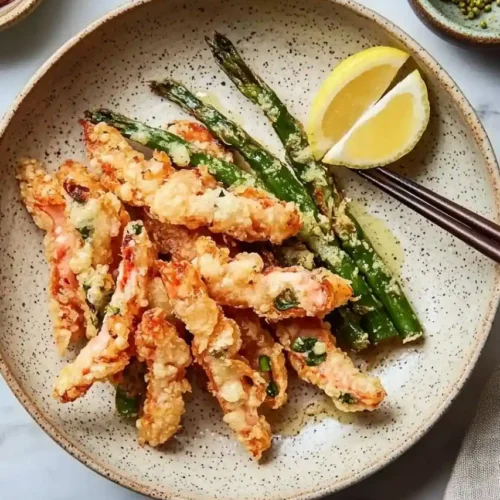
Salmon Tempura
Today, we’re diving into Japanese cuisine with a delicious seafood favorite—salmon tempura! This is perfect for seafood lovers. I used sockeye salmon for its rich flavor and served it with fresh lemon wedges and soy sauce.
Ingredients
Main Components:
- 1 lb sockeye salmon fillets cut into ¼-inch thick strips
- ½ cup all-purpose flour
- ½ cup cornstarch
- ¼ teaspoon salt
- 1 large egg yolk
- 1 cup chilled seltzer or club soda
- 2 –3 ice cubes
- 2 cups frying oil vegetable or canola oil
Optional – Tempura Vegetables:
- ½ cup bell peppers cut into thin strips
- ½ cup zucchini sliced into rounds or sticks
- ½ cup mushrooms sliced
For Serving:
- Soy sauce or tempura dipping sauce
- Lemon wedges
Instructions
Step 1: Prepare the Salmon
Selecting and Cutting the Salmon
- Use high-quality sockeye salmon fillets for the best texture and flavor. Sockeye salmon has a firmer flesh compared to other varieties, which helps it hold up well during frying.
- If you have a whole fillet, slice it into ¼-inch thick strips (about 3–4 inches long). These bite-sized pieces allow for even cooking and make them easier to dip in the batter.
Removing Excess Moisture
- Pat the salmon strips dry using paper towels. This step is crucial as excess moisture can prevent the batter from adhering properly and may cause splattering when frying.
Step 2: Prepare the Tempura Batter
- Tempura batter is what gives the salmon its signature crispiness. The key to achieving a light and airy texture is to keep the batter cold and avoid overmixing.
Mixing the Dry Ingredients
- In a large mixing bowl, combine equal parts all-purpose flour and cornstarch (for example, ½ cup each). Cornstarch helps create an extra crispy coating.
- Add a pinch of salt to enhance the overall flavor of the batter.
Adding the Wet Ingredients
- Separate one egg yolk and add it to the dry ingredients. The egg yolk helps bind the batter and adds richness.
- Slowly pour in chilled seltzer or club soda (about 1 cup) while whisking. The carbonation in the soda creates tiny air pockets, making the batter light and crisp when fried.
- Add 2–3 ice cubes to the batter. Keeping the batter cold prevents the formation of gluten, which can make the coating dense rather than crispy.
Mixing the Batter
- Gently whisk the batter until just combined. Small lumps are okay—overmixing can make the tempura coating heavy and chewy.
Step 3: Heat the Oil
- Proper oil temperature is crucial for frying tempura correctly. Too hot, and the batter will burn before the fish is cooked. Too cold, and the tempura will absorb too much oil, becoming greasy.
- Use a deep saucepan or skillet and fill it with at least 2 inches of oil (vegetable, canola, or peanut oil works best).
- Heat the oil to 350°F (175°C). Use a kitchen thermometer to monitor the temperature.
- If you don’t have a thermometer, test the oil by dropping a little batter in—if it sizzles and rises immediately without burning, it’s ready.
Step 4: Dredge and Fry the Salmon
Coating the Salmon
- Lightly dust each salmon strip with flour, shaking off excess. This helps the batter stick better to the fish.
Dipping and Frying
- Dip the floured salmon into the cold tempura batter, letting any excess drip off.
- Carefully place the battered salmon into the hot oil. Work in small batches to prevent overcrowding, which can lower the oil temperature and make the tempura soggy.
- Fry for about 2 minutes, turning occasionally, until the coating is light golden and crispy.
- Use a slotted spoon or tongs to remove the salmon tempura from the oil and place it on a wire rack or paper towels to drain excess oil.
Step 5: Optional – Frying Vegetables
- To make your meal more colorful and flavorful, you can fry some vegetables alongside the salmon. Good options include:
- Bell peppers (cut into thin strips)
- Zucchini (sliced into rounds or sticks)
- Mushrooms (sliced or whole)
- Follow the same method: dip in batter and fry for about 1½ to 2 minutes until crispy.
Step 6: Serve Immediately
- Salmon tempura is best served fresh and hot. Arrange the crispy salmon and vegetables on a serving platter and pair them with your favorite dipping sauces, such as:
- Soy sauce
- Ponzu sauce
- Tempura dipping sauce